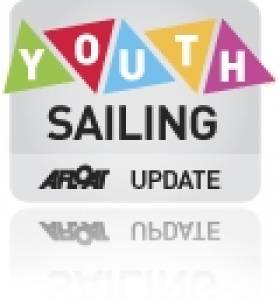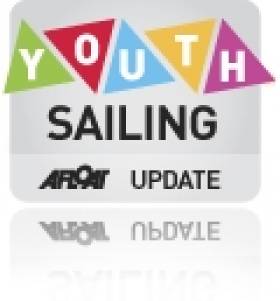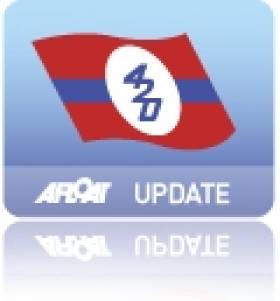Displaying items by tag: 420
#youthsailing – Youth sailors Peter McCann and Harry Whitaker from Royal Cork took third overall in the 420 dinghy at Kiel week, Germany at the weekend. Douglas Elmes and Colin O'Sullivan of Howth finished fifth overall in the same 154–boat fleet. As Afloat.ie reported earlier, there was also early success for new 29er skiff duo Harry and Johnny Durcan, also of Royal Cork, who finished 11th in their 86–boat fleet.
The youth sailors are returning to Ireland today after the exceptional results at Kieler Woche, one of the largest international regattas in the world with 39 classes and 5000 sailors competing in the week-long event.
Four Irish 420 crews took part in the event, with all four achieving top 10 results over the four days of racing, in the 154-boat fleet.
A nail-biting final two days saw two Irish crews, McCann and Whitaker (RCYC) and Elmes and O'Sullivan (HYC/MYC) swapping places at the top of the fleet, until a disappointing final race for both boats gave Ireland third (McCann/Whitaker) and 5th (Elmes/O'Sullivan) overall.
The event was won by the USA, with France taking second place, and GBR fourth.
For a number of years the Irish Laser sailors have been achieving impressive international results, but in recent years the 420 standard has steadily improved and the Kiel results are being described as a 'major breakthrough' for Irish 420 sailing.
The 420 Munster Championship takes place in Dunmore East next weekend, 4th and 5th July.
#inss – Last week, Sailing on Saturday featured the Royal Cork Yacht Club, the oldest in the world, as it comfortably donned the mantle of the ISA/Mitsubishi Motors Sailing Club of the Year 2015. This morning, we find ourselves involved with what may well be the newest sailing club in the world, the Irish National Sailing Club. It is certainly, thanks to being inaugurated nearly three months after Youghal SC was founded on 28th October 2014, the newest in Ireland. W M Nixon tries to explain it all as he finds himself in the world of Irish sailing's most complete dynamo.
Alistair Rumball is a Life Member of the Awkward Squad. Cage-rattling and pot-stirring are second nature to him. But it's not because of experiencing an unhappy childhood. On the contrary, while growing up in Malahide, his boyhood summers were bliss. He and his brother Arthur had as much sailing as they could want, fitted in between part-time jobs raising pocket-money with a morning picking potatoes at Dermot Dickie's farm along the Broadmeadow Estuary, followed by an afternoon of sailing the sea with the sun always shining, and then maybe an evening of club racing followed by the easy camaraderie among kids who are comfortable with boats.
It was an idyllic maritime environment which, over the years, has produced some of Ireland's top racing and cruising sailors. But while the young Rumball was no slouch on the race-course, the strongest feeling he had about sailing was the sheer fun of it all, the totally absorbing wonder of being in a boat and hauling on ropes to make sails change shape and help you along your chosen course over the always interesting sea.
Although he graduated from Trinity College Dublin as an engineer, he increasingly had this almost evangelical attitude to spreading the good news about the fun of sailing. And while he has something of a reputation – to say the least - for being confrontational, it's central to his contradictory character that he's an extremely good teacher. If somebody shows the slightest genuine enthusiasm about wanting to learn to sail, Alistair Rumball has been prepared to go to endless lengths to teach him or her to do so, and to do so with enjoyment.
Underlying that, we find the first of his gripes about the modern sailing scene. He reckons that it has become far too serious. Don't think for a moment, though, that he believes in a frivolous approach to boats and sailing. He's deadly serious about having everything just right as regards safety and function.
But once that's sorted, then he firmly believes that you should go out and enjoy it. He waxes lyrical about moments of sheer sailing ecstasy he has enjoyed in a wide variety of boats in many sailing locations worldwide. And whatever he may have formally set out to be in a professional career, his working life has been spent in and around boats, getting people introduced to boats and out afloat, sometimes on an almost industrial scale.
Time was when sailing skills were something you acquired by a sort of osmosis through family tradition, club opportunities, and friendship examples. That's mostly how Rumball himself learned to handle a sailing boat. But he seems to have this almost messianic zeal to teach people to sail, and he became convinced that the future lay in more structured training with a proper syllabus.
Having taken a long hard look at the population distribution of the Greater Dublin area and where they might best get afloat in worthwhile numbers, in 1978 he acquired the assets of a moribund organisation, the Dun Laoghaire Sailing School, and soon found himself giving his first lessons to two pupils using a fibreglass-clinker Darragh 14 knockabout sailing dinghy which they'd launched from the public slipway in the Coal Harbour in Dun Laoghaire. The long journey had started towards an organisation whose activities today today include top-of-the-line race training in 1720s in winning mode:
The majestic granite harbour of Dun Laoghaire was a cold place in 1978 for any young enthusiasts trying to set up an independent sailing school on a commercial basis. For the powers that be, sailing was something to be learned through family and clubs under the Junior Training Programme of the Irish Yachting Association. If you were a young person or adult from a non-sailing background but keen to learn, unless you'd an obliging and patient friend from within the sailing establishment, the expectation was that you'd take yourself off to somewhere far away like the Glenans Ireland bases in Baltimore and Bere Island and Clew Bay, and eventually reappear after a decent interval with enough experience, newfound ability and contacts to make the grade in the Dublin Bay sailing scene, where the very thought of a raw in-harbour sailing school for outsiders seemed distasteful to the establishment.
Yet hidden away in the southwest corner of Dun Laoghaire harbour, here was this gadfly of the sailing scene, Can–do Alistair with his rough and ready sailing school enthusiastically recruiting pupils anywhere and everywhere, and taking them afloat in boats which may not have been in the most pristine condition, and certainly set sails which would not be winners on the race course, yet they were safe and able, and so were he and his instructors.
Over the years, an entire cohort of people, mainly from Dublin but also from all over Ireland with a useful smattering of pupils from abroad, came to boats and sailing thanks to this wild-haired character whose love of his demanding work shone through everything he did.
Gradually the fleet expanded, and so too did the "Rumball Group's" activities, even though the very limited availability of premises on the Dun Laoghaire waterfront meant that every little square foot they had always seemed to serve at least three different purposes. But they were getting there, they opened a retail outlet in the town to sell boat gear and equipment which became Viking Marine, the school promoted itself to being the Irish National Sailing School, and they were well settled in place, using every inch of space on the ground floor of the interesting little building on the southwest corner of the harbour which used to be the Nautical College.

The man and his machines – Alistair Rumball and his chariot outside the Irish National Sailing School's HQ in Dun Laoghaire. Photo: W M Nixon
Centuries ago, seafaring education was given a significant role in Irish life in the late 1700s, the 1800s, and the early 1900s with the old Marine School a fine building on the south quays in Dublin. But its premises were re-allocated for development purposes and the school itself had its final home in Clontarf before being absorbed only as a vague memory into what is now Mount Temple Comprehensive school.
These days, the marine education focus has moved to Cork with the fabulous new National Maritime College in Ringaskiddy, but for that low period in Irish maritime life in the mid 20th century, one of the few keepers of the flame was Captain Tom Walsh who operated the little Nautical College in this fairly inconspicuous Office of Public Works building now hidden away behind the Dun Laoghaire Motor Yacht Club.

Captain Tom Walsh in teaching mode in 1957 in the INSS building when it was the Nautical College.

The 110ft barquentine which Jack Tyrrell designed for Captain Tom Walsh's Nautical College in 1954 in the hope that it would inspire the building of an Irish Tall Ship
It was the gallant Captain Walsh who in 1954 commissioned Jack Tyrrell of Arklow to design a 110ft sailing ship – a barquentine – to be Ireland's very own tall ship, our first sailing training vessel. God bless the good captain, but he was convinced that if he could just get someone in Government to see these inspiring plans, then such a ship would be on the way.
You can imagine just how far such a visionary idea travelled in the deadly dull Ireland of the 1950s. Far from getting a proper training ship built, Captain Walsh had enough trouble keeping his college in being. Yet he was a gentleman and enthusiast to the end, and after retirement he augmented his pension by testing compasses in yachts, which I remember well as he did it for me with a little cruiser in 1981. The only mutually convenient time it could be done was on a Saturday evening, and I'd to get the boat from Howth to Dun Laoghaire to do it, but the actual swinging of the compass by Tom Walsh was such a pleasant and educational experience that any thoughts of being at some Saturday night party were entirely banished.
So when you go into the main premises of the Irish National Sailing School today, it's natural to remember Captain Tom Walsh, and I like to think that he would thoroughly approve of the old building's current usage, for Alistair Rumball and his team are mighty busy during what must sometimes be an 18-hour day, and just this week – before the sailing season is really fully under way – Monday was typical, with 185 schoolkids bussed down from Maynooth for a day's coaching afloat, followed by all sorts of gatherings including a committee meeting of the newly-formed Irish National Sailing Club.
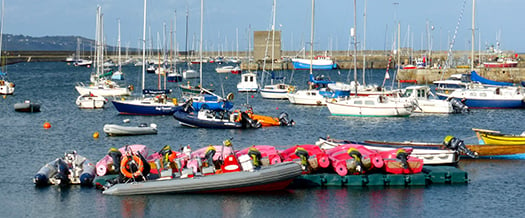
Space is so constrained that a floating dinghy park has to be used to store the smaller craft. Photo: W M Nixon
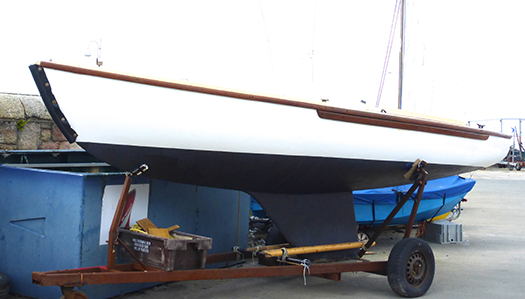
Thanks to the special INSS fendering devised by Arthur Rumball, this 35-year-old Squib has survived many seasons of tough teaching in good order. Photo: W M Nixon
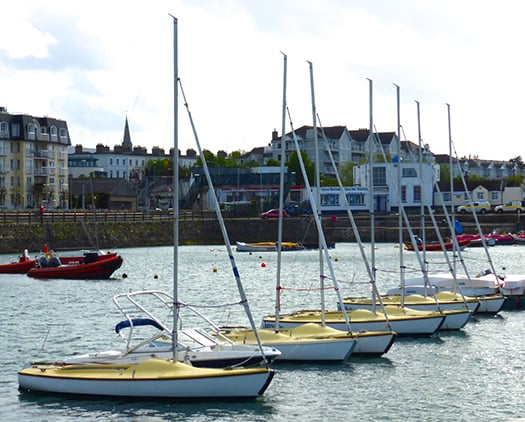
To economise on space, the Squibs berthed here, with the INSS building in the background, are double-moored. Photo: W M Nixon
Of which more anon, for this bare outline gives only a hint of the INSS's complex programme. The Rumball theme is that you have to keep operations and facilities flexible to cope with fluctuating demand, for at the height of the season the school is operating a fleet of 200 boats ranging from kayaks through sailing dinghies of increasing size, then on into keelboats of which some well-fendered Squibs are the workhorses while 1720s provide the glamour input, and finally at the top of the tree there's the Reflex 38 Lynx, bought from Galway this past winter, and becoming part of a programme headed by Alistair's son Kenneth – a Silver Youth Medallist in the 420 – who is now a fully-qualified offshore racing pro teacher, but also races the 1720s while being main operations director of a school which has five full–time employees, but in all has sixty staff at the height of the season.
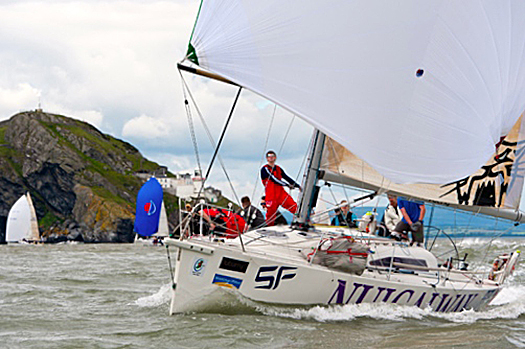
The latest addition to the INSS fleet is the Reflex 38 Lynx, seen here racing for NUI Galway during the Round Ireland. In 2015, Lynx has already scored a second overall in ISORA racing skippered by Kenneth Rumball.
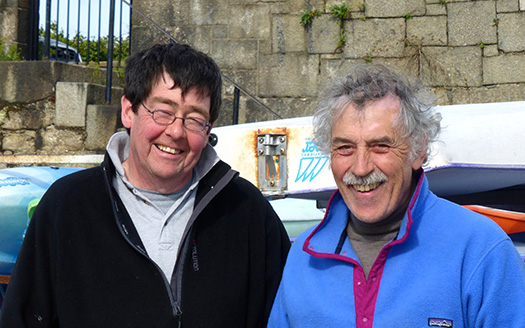
Brothers in business – seen here with his brother Alistair, Arthur Rumball (left) runs the often very busy INSS boat maintenance facility. Photo: W M Nixon
As to shoreside facilities, each summer they set up an additional seasonal summer base to the west of the West Pier with top-of the-line Portakabins at Salthill to provide facilities for those sailing dinghies and kayaks, and in addition the INSS have their own boat-maintenance unit under Arthur Rumball beside the boatyard in the Coal Harbour.
So an impressive amount of things have happened since 1978, the best of them surely being that Alistair persuaded Muriel, a country girl from one of the most beautiful parts of County Carlow, to marry him. For Muriel is a teacher by profession, and adept at being the peace-maker who smooths the waters after Alistair has been making waves, which even now still seems to be just about all the time.
That said, he gives the impression of having so many chips on his shoulder about the perceived opposition to his ventures by those in authority that you begin to think it might be just a bit of an act, for underneath it all he has a heart of gold, yet with the spirit of a lion who will fight the good fight to defend his territory and the interests of his family, friends, trainees and businesses.
The quality of the man was well revealed when the economic recession struck. At the height of the boom years, the Irish National Sailing School had a throughput of more than 2,500 people per month coming new to sailing, and it had become a vibrant and trendy part of the recreational fabric of good-time Dublin. Then around 2008, the economy went into free-fall. But the INSS survived both by making severe cutbacks in everything, and utilising another string in Alistair's bow.
Because of his ready enthusiasm to undertake just about everything and anything to do with boats, back in 1982 he'd looked after some waterborne scenes with classic small craft for the Channel 4 TV comedy-drama series The Irish RM, starring Peter Bowles and Bryan Murray, which went out between 1983 and 1985. It was grand at the time, but thirty years down the line it now seems to have a dose and more of the Paddywhackery about it. However, that was neither here nor there for Alistair Rumball in 1982, for it gave him a lucrative little sideline, and over the years since he has been the man to go to if you want to set up boats and sailing ship scenes in the Irish movie-making business.
So it's ironic, when we remember that Malahide was where the rather mouldy old Vikings of Dublin made their last base after their city had been captured by the Normans in 1171, that it should be a Malahide boy who has emerged as the behind-the-scenes captain of ships for the filming of the blockbuster series Vikings.

When you've spent most of your working life teaching people to sail, tutoring Thespian Viking crewmen on a Wicklow lake is just an ordinary part of another day at the office.
It has all been happening for some years now up in the Wicklow mountains and out on the Wicklow lakes, which have passed themselves off very well as Norwegian fjords, yet can double quite effectively as the coastal and riverside scenery of the many places where the Norwegian Vikings wreaked mayhem.
Who knows, but maybe with the passage of time the epic Vikings series will come to be seen as the epitome of Scandiwhackery, but for now, it certainly does the business . For as the Irish economy fell off a cliff, Alistair Rumball soared aloft in creating, managing, and manoeuvring a very authentic and substantial Viking longship flotilla which has provided a proper Tinseltown income to make all things possible, while helping underwrite the future of the Irish National Sailing School.
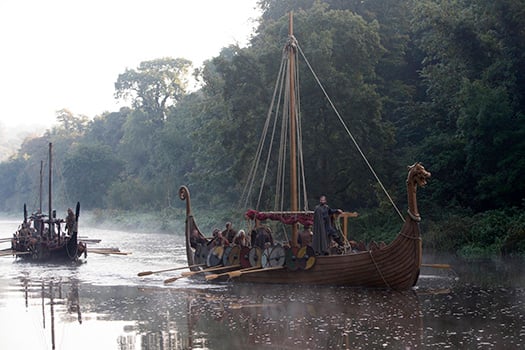
Lough Dan in County Wicklow - where Erskine Childers first sailed around 1890 – has proved remarkably versatile in providing backgrounds for the Vikings which could either be Norway itself, or else the shores of places they are raiding
But it's extraordinarily demanding and time-consuming work, even if he has a staff of 150 specialists up in the Wicklow hills, and after a year or two it became clear that he was trying to do too much. So four years ago his son Kenneth, who is now 27 and was at the time working as an accountant, moved in to take over the direction of the sailing school, and as the recession has started to recede – last year they had monthly numbers pushing back towards the 2,000 mark - Kenneth's energetic and all-encompassing input is seeing the school increasing the scale of its operations, particularly in what might be called the post-graduate side with the development of 1720s at top race level. Now the acquisition of Lynx has developed things further - she has already made what was a rather hasty debut in the first ISORA of the year, but despite being only minutes out of the box, they placed second overall, and that only by six minutes.
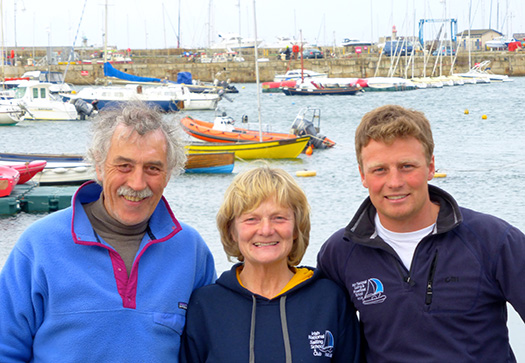
Alistair, Muriel and Kenneth Rumball. Photo: W M Nixon
This placing of racing as a natural part of the INSS syllabus has in turn led to the need for an officially-constituted club to comply with race entry requirements. But in reality the INSS has had a genuine club atmosphere for years, indeed it has more of a truly club-like atmosphere than many a historically-constituted old yacht club. So it was only a formality to bring the Irish National Sailing Club into being in January 201, but it's for real, here's a pic of the Committee of the new club meeting in the old Tom Walsh building on Monday, and if you want to join, it will cost you the outrageous sum of €10.
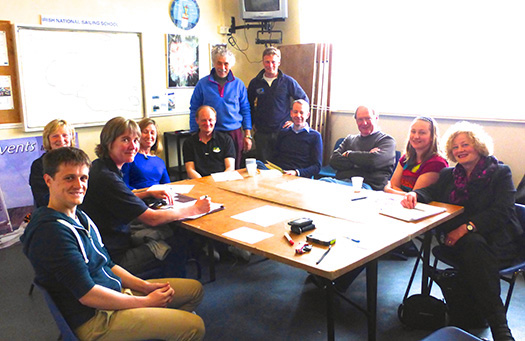
The committee and school management of the newly-formed Irish National Sailing Club are (left to right) Glyn Williams (foreground), Muriel Rumball, Joan Sheffield, Caroline Herron, Robin Jones, Alistair Rumball, Kenneth Rumball, Garrett O'Malley, Dermot Igoe, Heather Blay and Mary Beck. Photo: W M Nixon
As to how Alistair Rumball views the impending possible re-structuring of Dun Laoghaire as a cruise liner port, with inevitable limitations on the amount of sailing which can take place within the harbour, he is both an idealist and a realist.
Like many of us, he dearly wishes that this splendid granite creation could be seen as a cherished part of our heritage, not as something to be used to generate income to turn a crude profit or even just to pay its own maintenance costs. Rather, we'd ideally like to see it treated as a national asset to provide vital recreational space for everyone afloat and ashore.
But Alistair Rumball senses that the government's determination to use just about everything in public ownership to generate income will win the day, and he is already being realistic about what the regular if summer-emphasised arrival of cruise liners will mean.
In fact, he may even derive a certain sardonic satisfaction from seeing the Dun Laoghaire sailing establishment having to contemplate accepting conditions with which his school has complied ever since he began operating it.
"People should realise" he asserts, "that there are already two clearly-define shipping channels in Dun Laoghaire Harbour. One is from the harbour entrance to St Michael's Wharf, which will simply be retained if the cruise liners come. The other, much less widely known, is supposed to be from the harbour entrance to the berth at the Band Stand on the East Pier. Even at present, you are not meant to operate under sail in either of those channels, but an awful lot of boats do so."
"However, as we are a commercial operation, we have a strict policy of complying with regulations and carrying out our sail training and teaching operations in the western part of the harbour, clear of the main channel. So a cruise liner should not affect our in-harbour activities, while our larger craft going out into the bay will have to comply with shipping regulations in the entrance like everyone else".
Whatever happens, we may be sure that the Irish National Sailing School and the Irish National Sailing Club - and their splendid founder - will continue to be a thorn in the side of those who take themselves too seriously and have an inflated idea of their own importance. But if you've never been in a boat before and know nobody in sailing, yet feel a growing enthusiasm to go sailing in Dun Laoghaire, you now know where to go to experience the real thing.
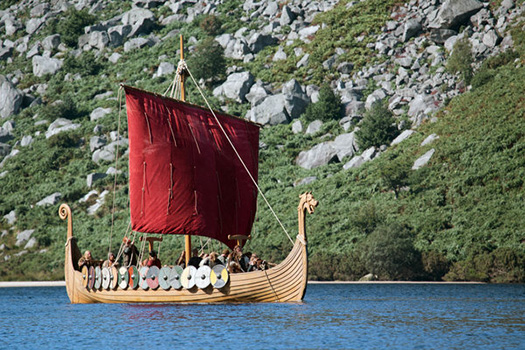
The other side of the INSS show – a Viking ship looking good on Lough Dan
#420 – The 420 Leinster Championships were won by Douglas Elmes and Sean Waddilove at Howth Yacht Club at the weekend writes Graham Smith. The event served as the second leg of the 420 Class Association trail series for teams for the Open and Ladies World Championships and Junior European Championships.
Thirty competitors arrived down to Howth Yacht Club on Saturday morning to be greeted by a 20-30 knot easterly wind, heavy rain and rough seas. After consulting weather forecast and his race Committee PRO Richard Kissane decided to abandon racing for the day. The Saturday evening dinner was moved forward to lunch time and the sailors took the afternoon off to go to the cinema or study for exams.
The sailors headed out on Sunday morning in glorious sunshine and a 5-10 knot westerly breeze with the intention of sailing four races. Alacoque Daly and Anna Kelly from Royal Cork Yacht Club/Tralee Bay Sailing Club lead the fleet for most of the first race. With an easterly swell and a fading breeze making challenging sailing conditions, there were a number of lead changes before Douglas Elmes and Sean Waddilove from Howth Yacht Club eventually took the gun.
After a number of postponements and an abandoned race, the wind eventually settled when a very light south easterly filled. Peter McCann & Harry Whitaker from Royal Cork Yacht Club appeared to have a comfortable lead in the second race, until a misinterpretation of the sailing instructions handed the win to Lizzy McDowell and Anna O'Regan from Howth Yacht Club/ Malahide Yacht Club.
The third and final race was sailed in very light conditions and there were many changes in position as the competitors to find pressure and get down wind against the tide. When the race was shortened at the second windward mark, Lizzy McDowell & Anna O'Regan just managed to sneak across the line ahead of from Kinsale Yacht Club/Courtown Sailing Club.
When the final results were tallied it was clear that consistency paid off in the 3 race non discard event. Douglas Elmes & Sean Waddilove edged out Cliodhna Ni Shuilleabhain & Niamh Doran on a tie break to become Leinster Champions. Lizzy McDowell & Anna O'Regan were third overall. Alacocque Daly & Anna Kelly won the Silver fleet from Peter Fagan & Ben Walsh from Skerries Sailing Club and Shane McLouglin & Tim Coyne from Howth Yacht Club. Alex & Jamie O'Grady won a prize for best new sailors in a boat that they had never sailed before.
Howth Yacht Club was well represented by 15 sailors, thanks to a good turnout from the Club's 420 fleet and guest appearances from the Optimist sailors Jamie & Eve McMahon and Topper sailor Shane O'Brien. They all sailed extremely well in a very competitive fleet where there was close racing from start to finish. Hopefully they will continue practice their racing skills in club racing on Sunday mornings.
Malahide Yacht Club's sole representative was Lizzy McDowell. Colin O'Sullivan missed the event through illness and Cara McDowell is still recovering from a shoulder injury. The good news is all 3 should be fit to compete in the 420 World Championships in Japan, where they will be part of a 3 boat Irish Team.
420 Class Launch e-Book for Learning Dinghy Skills
#420 – The International 420 Class has launched the Exercise e-Book, a new online training resource targeted at providing world class training techniques and strategies on Performance Improvement for Coaches and Sailors.
The new International 420 Class Association Exercise e-Book provides a selection of carefully chosen performance training exercises, with accompanying video and commentary to provide sailors and coaches with a step by step path to improving their skills. From covering boat set-up to techniques at mark roundings, strategies and tactics on the startline to gybing in strong winds, the e-Book covers a diverse range of training exercises. The International 420 Class Association Exercise e-Book is provided free of charge to 420 sailors and coaches around the world.
The International 420 Class Association recognizes the valuable role coaches play in sailors' development and wants to provide equal opportunity to coaches around the world to access training techniques and improve their own skills. The e-Book provides a clear explanation of the purpose of the training technique, details of equipment required and guidance on how to evaluate performances for sailors of all abilities, as well as sections including boat preparation and setting up a 420. The video and animation break down the manoeuvres into easily digestible chunks. Additional advice, tips and debrief notes provide maximum guidance and best methods of benchmarking sailors' progress.
Reigning Olympic Gold medallist in the 470 Class and five-time 470 World Champion Mat Belcher thoroughly endorses the initiative. Australia's Belcher won the 420 World Championships in the year 2000, with his brother Daniel, and claimed a silver medal with his now wife Rike Belcher in 2004.
Belcher commented, "To help reduce the skills gap and make the sport more accessible to all must be one of our collective goals. I really applaud the initiative of the International 420 Class to launch this innovative training programme. Even for those sailors without a coach, they can read the e-Book and watch the videos and develop their own training programmes. This is a really fantastic resource."
Packed with imaginative training techniques, the e-Book will prove to be an invaluable resource for coaches and sailors. The range of exercises covers Basic, Racing and Advanced level sailors. The e-Book includes warm-up exercises, training exercises, boat handling and manoeuvre exercises.
Coming together with other sailors and a coach to train is a great experience, but the online resource will also help those who are training individually and unable to regularly work with a coach.
Nino Shmueli, International 420 Class Association President said, "The 420 Class' objective is to facilitate equal opportunity for access to training resources for 420 sailors and coaches around the world. We are fortunate to have developed the e-Book with renowned coach Nikos Drougkas, who is a regarded and inspirational coach to many. The 420 Class wants to revolutionize the availability of expert knowledge and make it available free of charge through the imaginative use of online platforms. Whilst developed by the 420 Class, the training resource is relevant for all dinghy and small boat sailors."
The International 420 Class Association Exercise e-Book is the second online training resource developed by the International 420 Class Association. In 2011, the 420 Class launched 420 to the Max, a range of free online videos introducing training techniques, for beginners and experienced sailors. Clear direction and guidance demonstrates how to master techniques in different wind and sea conditions and what to consider when undertaking manoeuvres. Available in English, French, German, Spanish and Japanese, the 420 to the Max videos have attracted in excess of 200,000 views – clear evidence of the worldwide appetite for online training.
Youth Sailing Thrills As Strong Winds Sweep Cork Harbour
#youthnationals – There were thrills and spills galore at Royal Cork Yacht Club today (Saturday) in the penultimate day of the Irish youth sailing national championships writes Claire Bateman. The ebb tide flowing out of the Eastern Bank in Cork Harbour and the opposing forces of the W/S.W wind gusting up to 26 knots made for difficult conditions for the ISA pathway sailors. Indeed so much so that the Laser 4.7s and Toppers had to make do with just one race before they were towed home. Meanwhile the Laser Radials and the 420s had an exhilarating day of racing but racing for the 420s was abandoned before Race 4 and the Laser Radials completed three races.
To quote Rory Fitzpatrick, Youth Performance and Development Manger: "I was out with the 420s and Laser Radials today and the whole fleet was incredibly impressive. The way they handled the exceptionally difficult conditions demonstrated clearly that these dedicated sailors have spent some considerable hours in their boats". It also has to be said that it is to the credit of the Race Officer for these two fleets, Alan Crosbie, that great concern for all the competitors was his primary objective and to see that all who were retiring or capsized were accounted for. He had a mother ship and rescue standing by. He was also heard on radio instructing all rescue and support RIBS to be alert to the fact there was another squall on its way. It brings your scribe back to one day some moons ago when he was dealing with a fleet of bucking bronchos all being skittish at the start of a race and the dulcet tones came over the radio saying "I'm watching you, they are watching you from the pin end and God is watching you from above". Today the dulcet tones came over the radio again to advise "this will be a black flag start as we have no time for messing today".
On the Optimist course as one approached the fleet in the morning, several competitors, prior to racing, went off on a reach and loud whoops of delight could be heard as the youngsters surfed the waves, here again under the watchful eye of the rescue RIBS. Once again, they sailed a longer day than any other fleet getting in another four races. One has to really admire the determined grit of these young sailors. Every inch of the Curlane Bank was utilised to day to give these youngsters the longest beat possible.
Forecast for tomorrow (Sunday) is for more strong wind and hopefully racing will be able to take place.
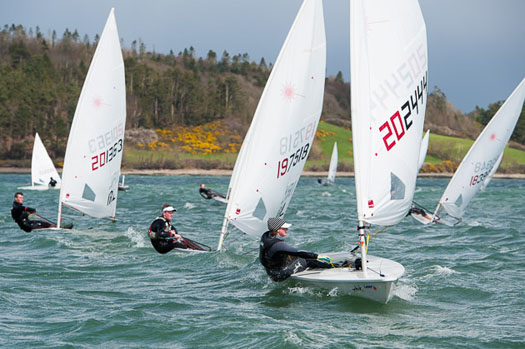

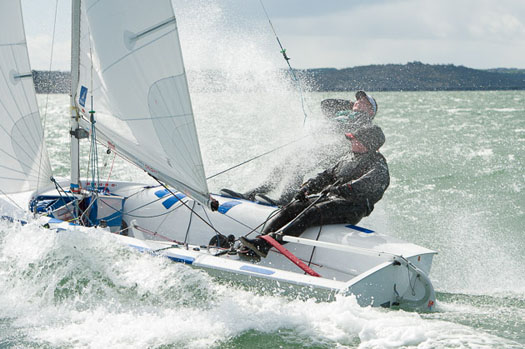

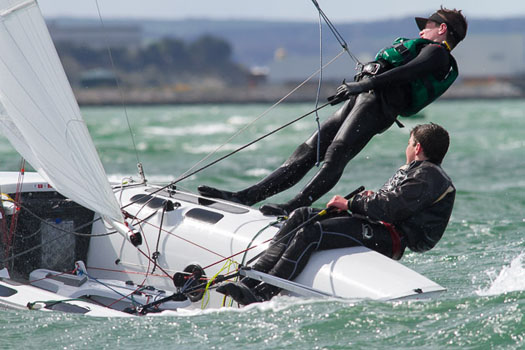
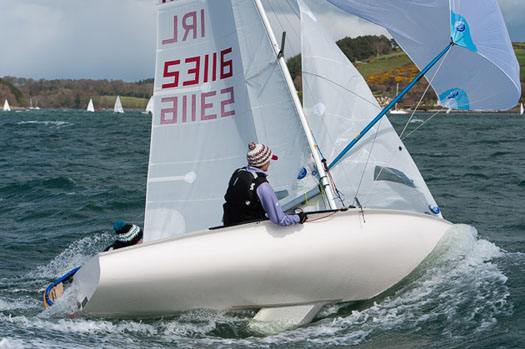
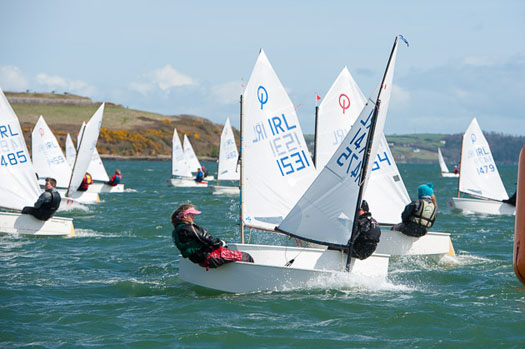
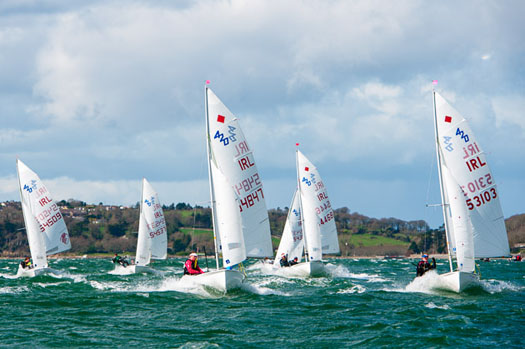

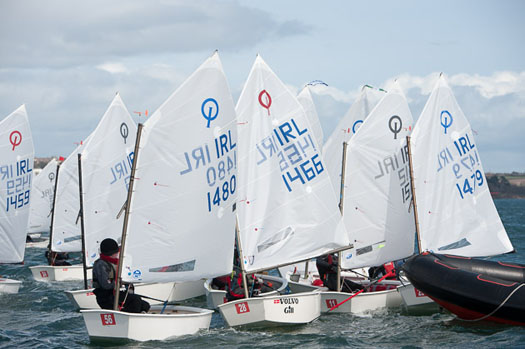





Radials & 420s Start Youth Nationals At Royal Cork
#youthnationals – Today saw the first day of racing at the ISA Pathway Trials and Youth Sailing Championships at the Royal Cork Yacht Club writes Claire Bateman. Today's fleets were Laser Radials and 420s. The Principal Race Officer was Alan Crosbie. The morning turned out to be foggy but there was a light south easterly breeze and the sun made an appearance making it into a pleasant day but still retaining some heat haze.
During the day the wind strengthened slightly and went more into the east with Alan Crosbie weaving his magic by sailing the 420s on the outer loop of a triangular course while the Radials sailed on the inner loop. For the next three days the fleets will be joined by the Toppers and the Laser 4.7s.
Meanwhile, not a mile away on the Curlane Bank, Race Officer Anthony O'Leary was performing his style of magic in enabling the IODAI Optimist Trials also to get in three races. There was no doubt he got the best of the wind from his position as it was somewhat stronger on this course and he got in three fine races for the sixty plus competitors and the races were over forty minutes each for two of them with the third being over fifty minutes.
The IODAI Optimist Trials will run over 4 days from today (Thurs) to Sunday. This is a qualifying event for the Optimist sailors to represent Ireland in 2015 - the top five at Optimist Worlds in Wales, next seven at Optimist Europeans in Poland and a number of sailors chosen for a development team that will sail at the French Nationals.
The 420s and Laser Radials are competing in the ISA Youth Pathway Nationals from today (Thursday,) while the Toppers and Laser 4.7s will compete from tomorrow, Friday to Sunday. Normally this is a qualifying event for the Youth Worlds, which are usually in the summer, but the 2015 Youth Worlds are in Malaysia in December which is a little too far away. Still an important event for all the classes as the Lasers compete for the honour of ISA Youth Pathway Nationals Champion, the 420 sailors are qualifying for the Junior Europeans and Worlds, while the Toppers are qualifying for the ISA Summer squads which will build up their skills for the Topper Worlds in Lake Garda. This is an open event for ALL Topper, 420, Laser 4.7 and Laser Radial sailors, which means the young sailors did not have to qualify to enter and it gives ALL sailors a chance to compete against each other on an even playing field.
All in all an excellent, if somewhat long day for the youth competitors but obviously scintillating and provided for plenty of chatter and camaraderie when coming ashore and bringing their boats back to the allotted compounds for each fleet.
Racing continues tomorrow (Friday).
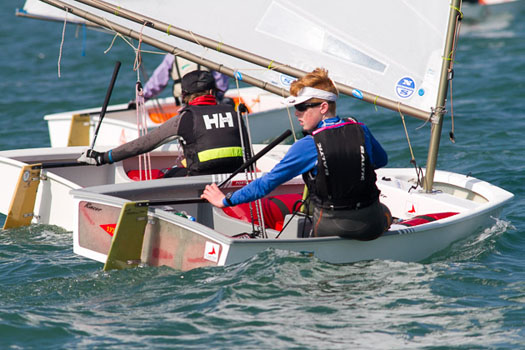

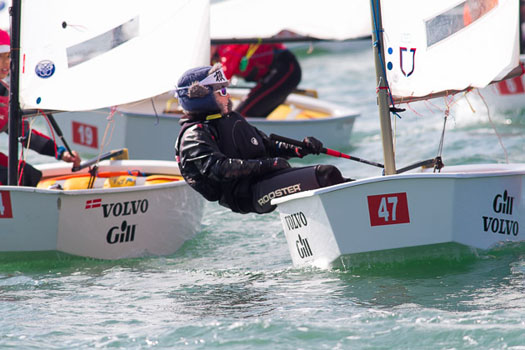

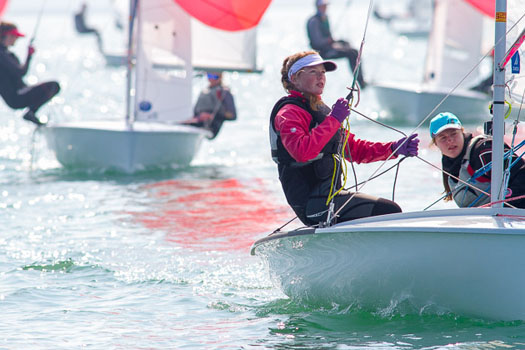
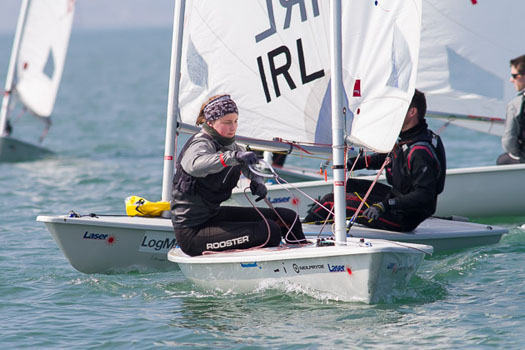
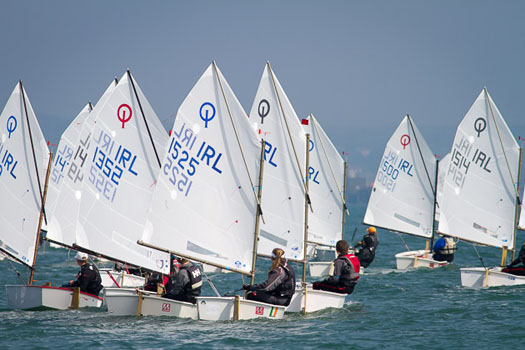
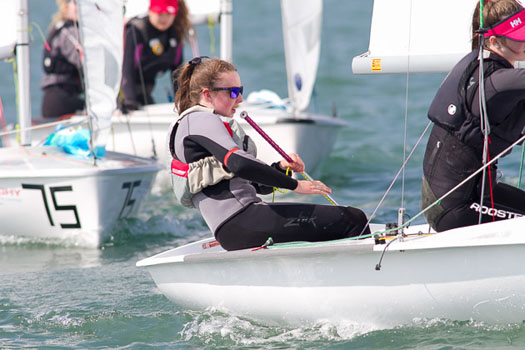

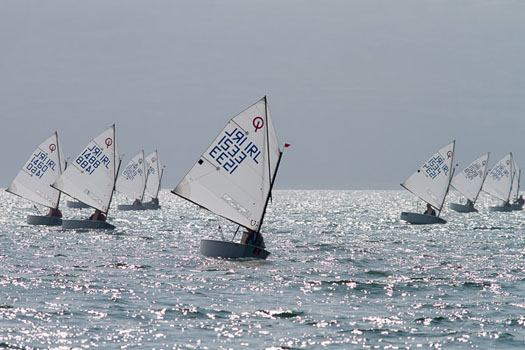
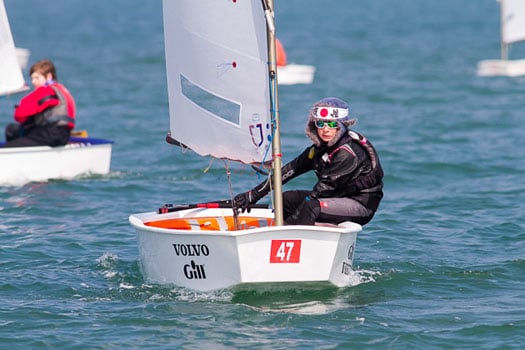
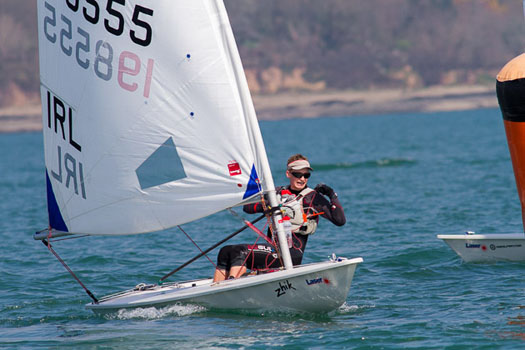
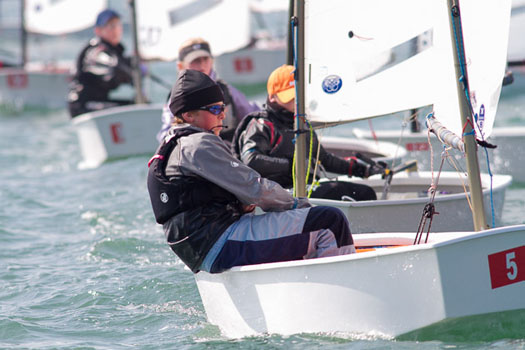
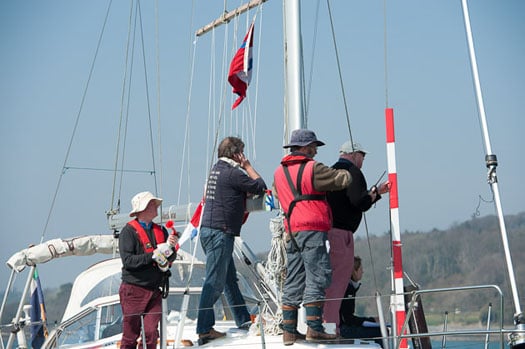


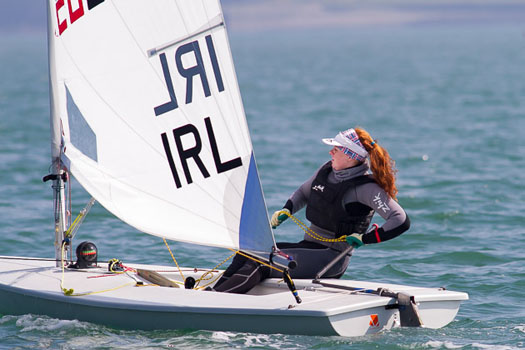
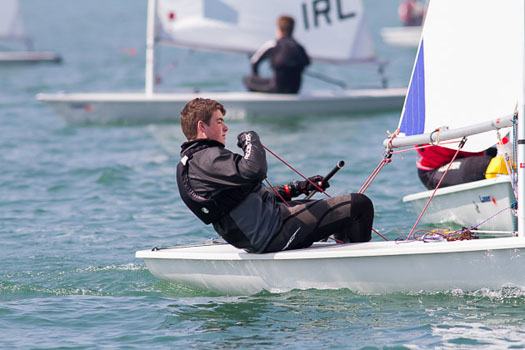
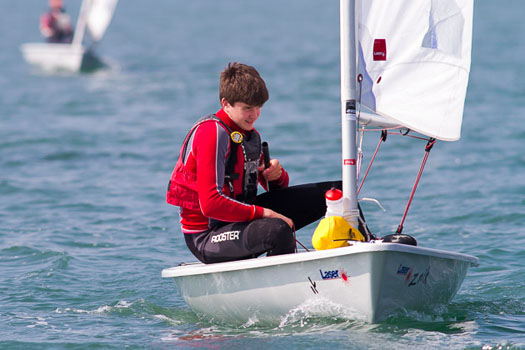
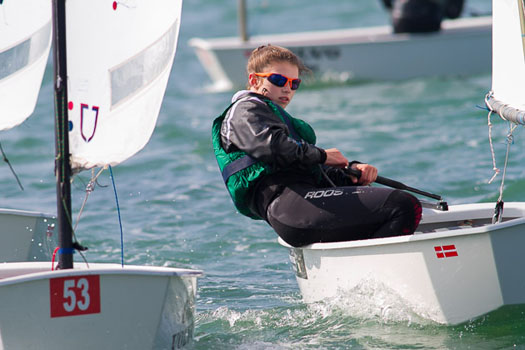
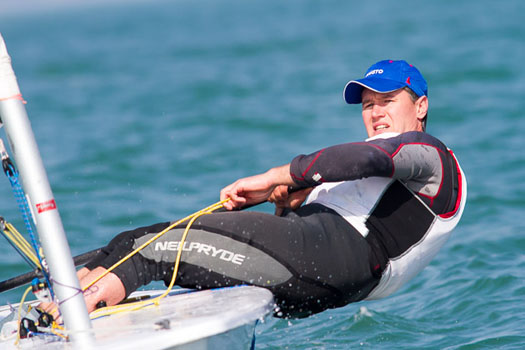
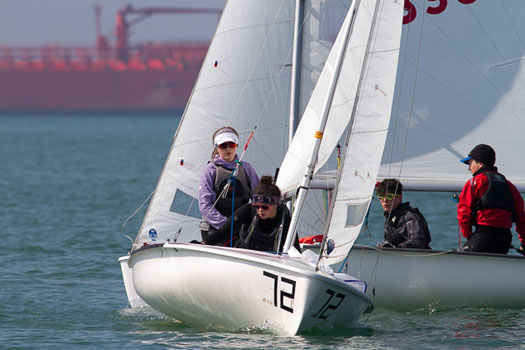
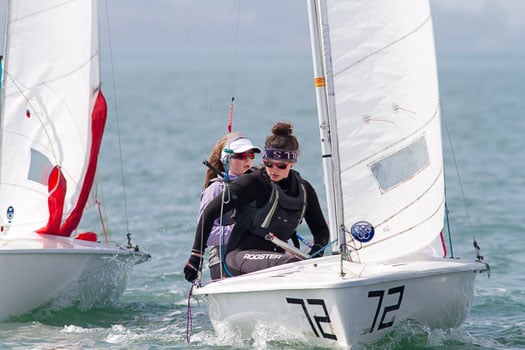
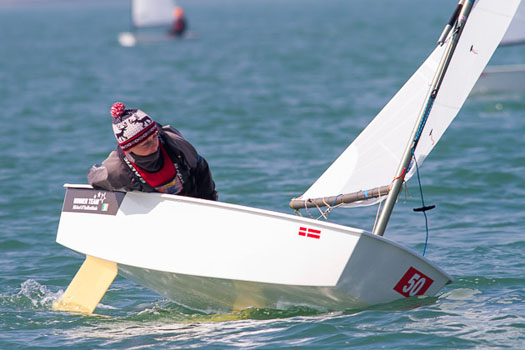

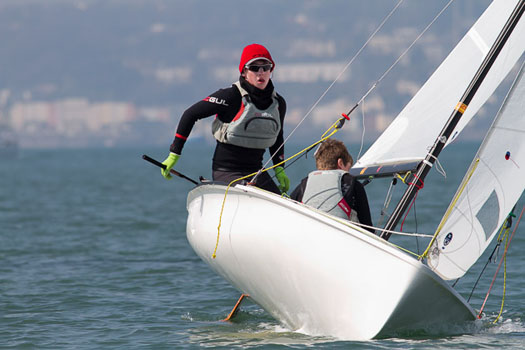

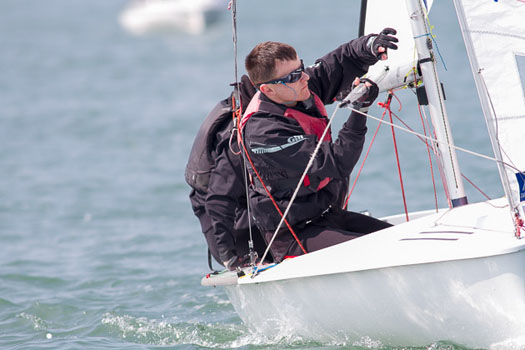
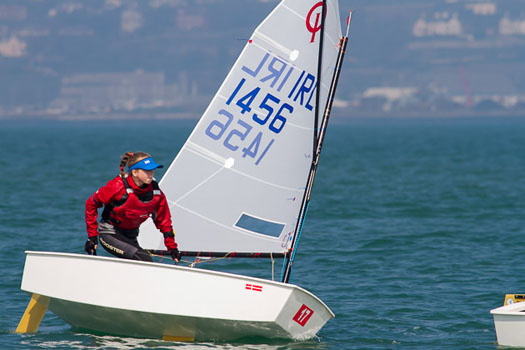
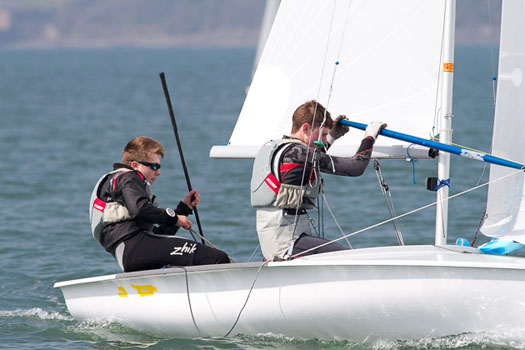



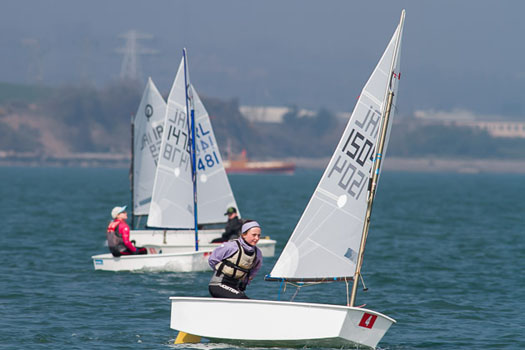
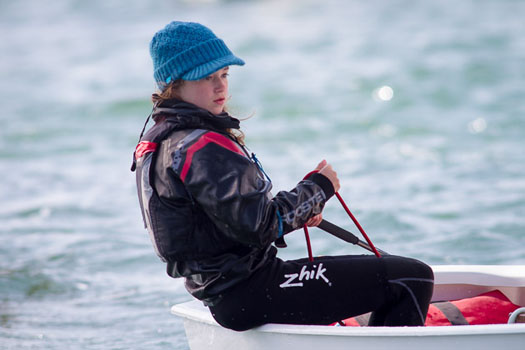
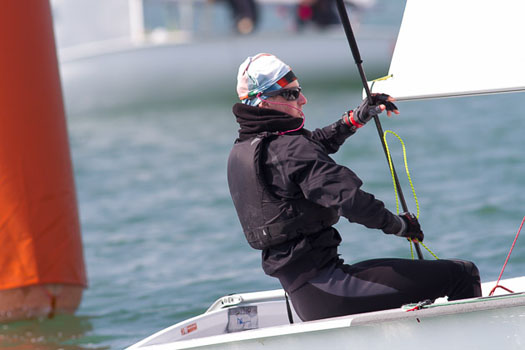
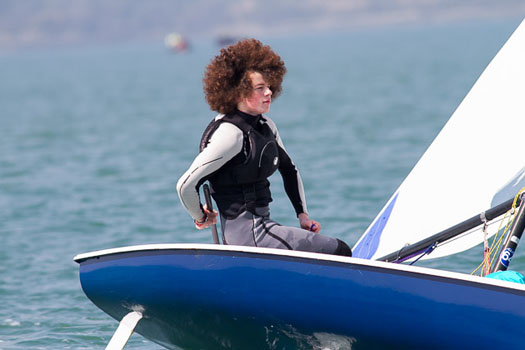
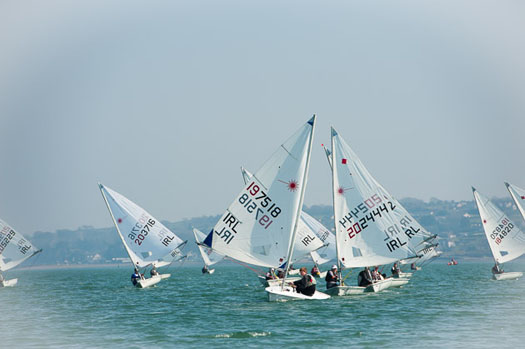

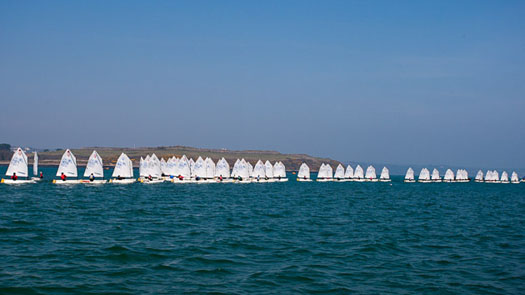
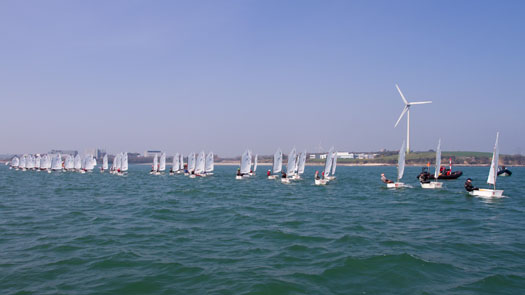
Irish 420 Dinghy Sailors Post Top Five Result at UK Inlands
#420 – Irish 420 dinghy sailors got the 2015 sailing season off to a great start with two top 5 results for Irish boats in the UK this weekend.
6 Irish 420s travelled to Rutland Water Sailing Club in Leicestershire for the 2015 420 Inland Championships.
For the UK sailors, this was the first in the 2015 Worlds and Europeans qualifying series, so racing was of a high standard in the two-day event, with a fleet of 49 competing.
Four races were completed on day 1 in sunny cold conditions with winds of 15 knots. Sunday was duller, and winds had dropped slightly, but an earlier start meant that the remaining three races of the series were completed.
UK youth pairing Clapp / Banham led from the beginning, but the Irish boats gave the home teams a run for their money, with Elmes / O'Sullivan (RCYC/HYC/MYC) finishing in second place overall, the UK's Burns / Shorrock and Davies / Keers in 3rd and 4th places, and RCYC's McCann / Whitaker taking 5th.
Royal Cork & Howth 420 Youth Sailing Duo Take Fourth In Spain
#420 – Irish youth 420 dinghy sailors Douglas Elmes (RCYC) and Colin O'Sullivan (HYC) took fourth place in the International Grand Prix Vila de Blanes this week, in Blanes, Spain.
The event was sailed in the 420, 29er and Europa classes, with 26 entries from Spain, Russia, Poland, Germany and Ireland competing in the 420 class.
The regatta was excellently run, with racing beginning at 9am most days to take advantage of the land breeze, which tended to die at midday, with sea breezes of 5-8 knots kicking in mid-afternoon. A full schedule of 10 races was completed with one discard in the series.
Elmes and O'Sullivan progressed gradually through the fleet, and a win in R10 on the last day secured fourth place overall, with top three going to Germany, Poland and Spain.
Final results downloadable below.
Kinsale Yacht Club Hosts Top Youth Sailors for All Ireland Challenge
#youthsailing – ISAF youth silver medallist Seafra Guilfoyle is a wild card entry into this weekend's All Ireland youth sailing event at Kinsale Yacht Club this Saturday. Crosshaven based Guilfoyle, who won world silver in Portugal in July, is slated against 19 other top Irish youth sailors who will compete in the double–handed Topaz dinghy fleet.
Over 30 sailors from 11 classes were considered and the Irish Sailing Association organisers say their selection process allocated places based on the numbers of boats declared by the classes attending their national championships. The full list on invitees for the weekend fixture is published below (with some crew names missing).
The host Topaz dinghy has two nominees from its own national championships held in Dingle and the RS Feva also has two sailors attending. The Optimist class has three sailors slated including top European championships perfomers, Clare Gorman of the National Yacht Club and James McCann of Royal Cork. 420 dinghy youths are represented by national champion Peter McCann and girls champion Cliodhna NiShuillebhain of the host club.
The Mirror dinghy is also included with teams coming from Lough Ree YC and Sutton Dinghy Club.
|
Class |
Helm |
Club |
Crew |
|
RS Feva |
Alison Dolan |
Blessington SC |
Grainne Young |
|
RS Feva |
Triona Hinkson |
Royal St.George YC |
Catherine Kelly |
|
RS200 - Youth |
Stephen Craig |
Royal St.George YC |
|
|
Optimist |
James McCann |
Royal Cork YC |
Michael Carroll |
|
Optimist |
Gemma McDowell |
Malahide YC |
|
|
Optimist |
Clare Gorman |
National YC |
|
|
Mirror |
Shane McLoughlin |
Sutton DC |
Oscar Langan |
|
Mirror |
Tiarnan Dickson |
Lough Ree YC |
Rory MacAllister |
|
Topper |
Hugh Perette |
National YC |
|
|
Topper |
Ros Morgan |
Skerries SC |
|
|
Topper |
Adam D'Arcy |
Royal Cork YC |
James Hassett |
|
Laser 4-7 |
Johnny Durcan |
Royal Cork YC |
Florence Lyden |
|
Laser 4-7 |
Rory Caslin |
National YC |
Scott Levie |
|
Topaz |
Jack Kiely |
Dungarvan HSC |
|
|
Topaz |
Paddy Cunnane |
Dingle SC |
|
|
International 420 |
Peter McCann |
Royal Cork YC |
Micheal O'Suileabhain |
|
International 420 |
Cliodhna NiShuillebhain |
Kinsale YC |
|
|
GP14 - Youth |
David Johnston |
Sutton DC |
|
|
Wild Card |
Harry Durcan |
Royal Cork YC |
Harry Whittaker |
|
Wild Card |
Séafra Guilfoyle |
Royal Cork YC |
Royal Cork's McCann & Walsh Win 420 Nationals Trophy at RStGYC
#420sailing – After nine great races on Dublin Bay, Royal Cork Yacht Club's Peter McCann and Arran Walsh claimed the 420 Nationals trophy last weekend writes Clodagh Lyttle. The teenagers sailed to victory in style, winning four races over the three day event hosted by the Royal St. George Yacht Club. 15 boats competed and seven of these were girls pairings. The fleet, aged between 14 and 18 enjoyed the courses set by PRO Richard Kissane. Full results downloadable below as a jpg file.
This result means that there are two homes in Crosshaven who have two National Champions in the family. Last week James McCann, Peter's brother won the Optimist Trophy and earlier this year Nick Walsh, Arran's dad won the Laser Masters Trophy.
McCann and Walsh managed to defeat the ISAF pair Robert Dickson and Sean Waddilove who were 20th in the World Championships in Germany. Similarly Cliodhna Ni Shuillebhain and Jill McGinley won the Ladies Title overcoming Lizzie McDowell and Cara McDowell who came 16th in the ISAFs. The standard of sailing in the Irish 420 fleet is extremely high, as another pair Harry Whitaker and Grattan Roberts also had a great result when they came 20th at the Junior Europeans .
After the prizegiving, 420 coach Ross Killian, Arran Walsh and Bill Staunton took the ice bucket challenge, much to everyone's enjoyment. The 420 sailors prepared two huge wheelbarrows of iced water and poured it on their coach.
The next 420 event is the Leinsters in Wexford Harbour on 13th and 14th September.




























